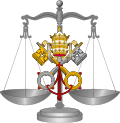Interpreter of medieval Canon law
In the history of canon law, a decretist was a student and interpreter of the Decretum Gratiani . Like Gratian, the decretists sought to provide "a harmony of discordant canons" (concordia discordantium canonum), and they worked towards this through glosses (glossae) and summaries (summae) on Gratian. [1] They are contrasted with the decretalists, whose work primarily focused on papal decretals.
Contents
Early decretists of the Italian school include Paucapalea, a possible pupil of Gratian's; Rufinus, who wrote the Summa Decretorum; and Huguccio, who wrote the Summa Super Decreta, the most extensive decretist work. [1] There was also a French school of decretists starting with Stephen of Tournai. [2]
